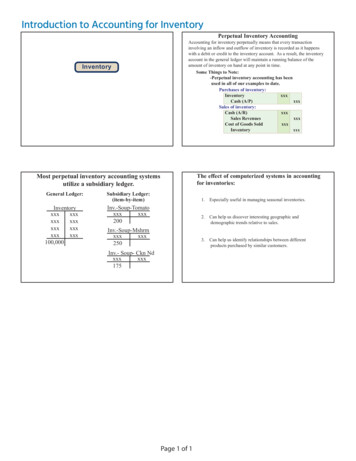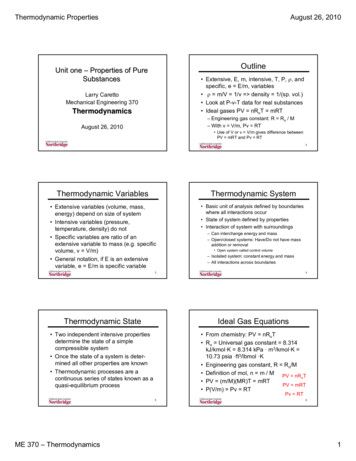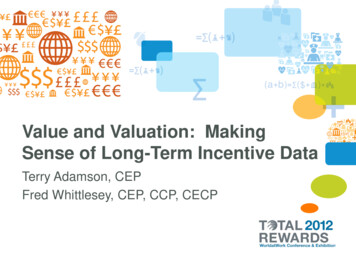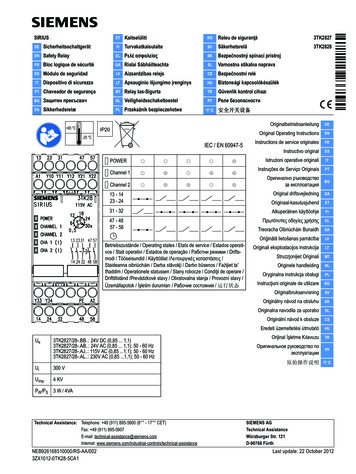
Transcription
The First 1,000 Days:Nourishing America's Future
1,000 Days is the leading non-profitadvocacy organization working inthe U.S. and around the world toimprove nutrition, particularly duringthe 1,000 day window between awoman’s pregnancy and her child’s2nd birthday. We work to promoteaction and investment in nutrition inorder to build a strong foundationfor children, their families and theirnations to thrive.
T H E F I R S T 1 , 0 0 0 D A Y S : N O U R I S H I N G A M E R I C A’ S F U T U R EContentsEXECUTIVE SUMMARYPage 3INTRODUCTIONNourishing America's FuturePage 7PA R T 1Nutrition in the First 1,000 Days — Why it MattersPage 9PA R T 2A Look at the First 1,000 Days in the U.S.Page 25PA R T 3An Agenda for the Next 1,000 DaysPage 37CONCLUSIONA Final Thought on the Next 1,000 DaysPage 47ENDNOTESPage 481
T H E F I R S T 1 , 0 0 0 D AY S : N O U R I S H I N G A M E R I C A’ S F U T U R EExecutive SummaryThe 1,000 days between a woman’spregnancy and her child’s 2nd birthday offer a unique window of opportunity to build healthier and moreprosperous futures. The right nutritionduring these first 1,000 days can havea profound impact on a child’s ability to grow, learn and thrive—and alasting effect on a nation’s health andprosperity.Good nutrition during pregnancy andthe first years of a child’s life providesthe essential building blocks for braindevelopment, healthy growth and astrong immune system. In addition,a growing body of scientific researchindicates that the foundations for lifelong health—including predispositionsto obesity and certain chronic diseases—are largely set during this 1,000day period.There are three crucial stages in thefirst 1,000 days: pregnancy, infancyand early childhood. During pregnancy, a mother’s health and eating habitshave a significant impact on the development and future well-being of achild. If a mother’s diet is not givingher the nutrients she needs to supporta healthy pregnancy and her baby’sdevelopment or if it is contributingto excessive weight gain—or both—itcan have serious, long-term consequences. From birth through the firstyear, breastfeeding provides unparalleled brain-building benefits andgives babies the healthiest start to life.Because of the unsurpassed benefitsof breastfeeding, the world’s leadinghealth agencies including the WorldHealth Organization (WHO) and theAmerican Academy of Pediatrics (AAP)recommend that babies are fed onlybreastmilk for their first 6 months, butmany mothers lack the support theyneed to meet this recommendation.And, finally, beginning at 6 monthsof age, children should eat a diversediet of nutrient-rich foods to helpfuel their growth and developmentand shape their taste preferencesfor healthy foods. Throughout earlychildhood, parents and other caregivers should also teach healthy eatinghabits and make sure that water andother non-sugar-sweetened beverages become a consistent part of achild’s diet. Deficiencies in key nutrients, poor eating habits and unhealthyweight gain during the early years of3a child’s life can set the stage for numerous developmental and healthproblems down the road.Unfortunately, in examining the nutritional health of U.S. infants, toddlersand their families, the data reveal anumber of troubling trends. Too manyAmerican women enter pregnancyoverweight or obese, and too manygain excessive weight while pregnant.This trend, underpinned by unevenaccess to quality preconception andprenatal care in the U.S., is contributing to tragically high levels of maternaldeath.In addition, the majority of U.S. babies are not breastfed in accordancewith AAP and WHO recommendations, and 1 in 5 babies in America arenever breastfed at all. The low rates ofbreastfeeding in the U.S. are driven byan overall lack of support for mothersto breastfeed, including a lack of access to paid maternity leave.Regrettably, the diets of U.S. infantsand toddlers now mirror the adultAmerican diet—with too few fruits,vegetables and other nutrient-rich
T H E F I R S T 1 , 0 0 0 D A Y S : N O U R I S H I N G A M E R I C A’ S F U T U R Efoods and too many added sugars and saturated fats. Thesedietary patterns are putting children’s health and development at risk. The data reveal that 25% of U.S. children between one and two years of age do not receive the recommended dietary allowance for iron (a key brain-buildingnutrient), and that 10% of U.S. children exhibit signs of overweight or obesity before reaching their 2nd birthday.While the problem of poor nutrition in the first 1,000 daysis pervasive across America, the burden falls hardest onlow-income families and communities of color, leading toa concentration of poor health outcomes in these popula-tions. One in five children under the age of six are part offamilies who struggle to put enough nutritious food on thetable. These children are less likely to thrive and more likelyto suffer health problems and developmental delays. Black,Hispanic, and other communities of color are most affectedby food insecurity, and, as a result, their children are lesslikely to get a strong start to life. In this way, poor nutritionearly in life contributes to deepening disparities and canmake a family’s climb out of poverty all the more difficult.The nutrition of all of America’s infants and children mustbe a social and economic imperative. By contributing to aTHE FIRST 1,000 DAYS IN THE U.S.SCORECARDA healthy and nutritious diet formothers during pregnancyNearly half of women gain an excessiveamount of weight during pregnancy.Good care for all mothersduring pregnancyThe U.S. has one of the highest maternal mortalityrates of any wealthy country in the world.Exclusive breastfeeding forthe first 6 monthsOnly 22% of infants are exclusivelybreastfed at 6 months.Nurturing, responsive care andfeeding of babies and toddlersLess than half of U.S. mothers receive anypaid time off to care for their newborn.The right foods introduced tobabies at the right timeAlmost 40% of parents introduced solidfoods to their babies too early.A healthy and nutritious dietfor babies and toddlers1 in 4 toddlers are not getting enough iron in theirdiets—a key nutrient for brain development.Water and other healthy beverageswith no added sugars for toddlersMore than half of toddlers and preschoolers consumeone or more sugar-sweetened beverage every day.The right knowledge and skills forparents and caregivers to properlynourish young children54% of mothers say they receive mixed messagesabout what to feed their young children.Consistent access to enough nutritiousfood for families of young children1 in 5 children under the age of 6 live in families thatstruggle to put enough nutritious food on the table.Societal investments in the wellbeing of every baby and toddlerMore than 25% of infants and toddlers live in poverty.
T H E F I R S T 1 , 0 0 0 D A Y S : N O U R I S H I N G A M E R I C A’ S F U T U R Eless competitive workforce and higher healthcare costs, theeffects of poor child nutrition affect us all. Experts estimatethat the health-related costs of food insecurity in America total 160 billion, more than a third of the U.S. Government’s budget deficit.broader social and economic factors. For this reason, ev-The quality of a child’s nutrition is shaped not only by decisions made by his parents and caregivers, but also byfuture health and well-being of all babies and toddlers ineryone has an important role to play in ensuring our nation’syoungest children get the nutrition they need for a strongstart to life. This report identifies a set of 10 “wins” that canhave a transformative impact on the first 1,000 days and theAmerica.10 WINS FOR THE NEXT 1,000 DAYS1Empower parents and caregivers with anunderstanding of the importance of early nutrition and knowledge of best practices for infant and young child feeding.2Educate and train medical and health care professionals, child care workers and others working with expectant mothers, babies and toddlerson the importance of early nutrition and optimalinfant and young child feeding practices.3Establish evidence-based dietary guidelines forpregnant women and children under age 2.4Invest in the research, monitoring and surveillance of the nutritional status of pregnant women and children under age 2.56Support healthy pregnancies by ensuring access to high quality preconception and prenatal care, nutrition education and obesity prevention programs.7Invest in paid parental leave and family-friendly workplace policies to support parents togive their children the strongest start to life.8Encourage companies to follow the WorldHealth Organization’s International Code ofMarketing of Breast Milk Substitutes whichprovides guidelines for the ethical marketing and promotion of infant formulas andfoods and beverages for young children.9Strengthen programs that reach low-income babies, toddlers and their families.10Building on existing initiatives and efforts, there is an opportunity to work in partnership to achieve these wins andimprove the nutritional health of America’s youngest children. Understanding the impact that nutrition has on lifelong health, school-readiness and giving children a fair startis a critical first step. As the science and the data clearlyshow, action to improve nutrition during the first 1,000 daysImprove support for mothers to breastfeedby creating breastfeeding-friendly communities, workplaces and healthcare facilities.Ensure that healthy, nutritious foodsare the affordable, available and desired choice for all families.must be part of any strategy to ensure optimal child development, reduce disparities and enable future generationsto live healthier lives. Finally, increasing our investments inbabies and toddlers and making their well-being a nationalpriority is essential to ensuring a brighter future for themand for us all.5
T H E F I R S T 1 , 0 0 0 D AY S : N O U R I S H I N G A M E R I C A’ S F U T U R EINTRODUCTIONNourishingAmerica’s FutureThe first 1,000 days of a child’s life—from pregnancy to age 2—offer aunique window of opportunity tobuild healthier and more prosperousfutures. It is a period of tremendouspotential and enormous vulnerability.During this time, how well or howpoorly a child is nourished has a profound impact on her ability to grow,learn and thrive. This is because nutrition during pregnancy and the firstyears of a child’s life provides the essential building blocks for brain development, healthy growth and a strongimmune system. And a growing bodyof scientific evidence shows that nutrition during the first 1,000 days affects our lifelong health—includingour predisposition to obesity and certain chronic diseases later in life—andcan even affect the health of futuregenerations.Poor nutrition early in life has repercussions beyond an individual child orher family. The effects can also be feltat a societal level—from a less competitive workforce to higher healthcare costs and greater inequality ofopportunity.In many ways, our understandingof the lifelong and societal impactsof nutrition in the first 1,000 days isstill in its infancy. This report represents an attempt to contribute tothat understanding and to galvanize amovement to ensure that every childin America has a healthy first 1,000days. In Part 1 of the report, we examine the foundational role that nutritionplays in giving young children a strongstart to life. In Part 2, we look at howyoung children and their families inthe U.S. are faring when it comes tonutrition. Finally, in Part 3, we highlightareas where greater action is neededto improve the nutritional health ofAmerica’s youngest children and theirfamilies.IN HER WORDSThroughout this report, we include perspectives from mothers andcaregivers of young children. Most of these perspectives were gatheredas part of qualitative research 1,000 Days conducted with 19 mothersand caregivers of babies and toddlers in 6 American communities. Afew were collected through the personal stories and photos womenshared with 1,000 Days on Facebook. The women who participatedin the qualitative research completed food journals to chronicletheir children’s diets and generously allowed researchers into theirhomes for interviews. In some cases, their names have been changedto protect privacy. We are deeply grateful to all the mothers andcaregivers who shared their stories with us and gave us permission topublish their words and images in this report.7
"If we want to shape the future, to truly improve the world, we have1,000 days to do it, mother by mother, child by child, for what happensin those 1,000 days through pregnancy to the second birthdaydetermines, to a large extent, the course of a child’s life, his or her abilityto grow, learn, work, succeed and by extension, the long term health,stability and prosperity of the society in which that child lives."1R O G E R T H U R O W, A U T H O R O F T H E F I R S T 1 , 0 0 0 D AY S : A C R U C I A LTIME FOR MOTHERS AND CHILDREN—AND THE WORLD
T H E F I R S T 1 , 0 0 0 D A Y S : N O U R I S H I N G A M E R I C A’ S F U T U R EPA R T 1Nutrition in theFirst 1,000 Days —Why it MattersAll parents share a common goal fortheir children—to grow up to be happy and healthy adults who achievetheir full potential. To that end, parentswant to give their children the verybest start. At no other time in life isthere a greater opportunity to impactso many aspects of a child’s development than during the “first 1,000 days”from pregnancy through 2 years ofage. Proper nutrition during this period builds the foundation for brain development and lifelong health. It canmean the difference between a life ofproductivity or struggle, and sometimes, between life and death.Throughout the past decade, therehave been rapid advancements in ourunderstanding of how children develop and how nutrition and other experiences in early life impact long-termhealth outcomes. New research in thefields of neuroscience and the earlyorigins of adult health is shedding lighton how our brains develop, how ourbodies become susceptible to diseases and how our capacities and skillsare either nourished or thwarted. Thescience of child development showsthat children need three fundamentalsupports in order to thrive as adults:appropriate nutrition; stable, responsive relationships with caregivers; andsafe, nurturing environments.2 Whenone or more of these supports is absent, a child’s physical, social, emotional and cognitive development cango awry, resulting in the loss of opportunities that are every child’s birthright.Poor nutrition early in life can havelong-term consequences not only forthe child but also for her family, hercommunity and even her offspring.The effects can be felt at a societal level—from a less competitive workforce,to higher health care costs, to greaterinequality of opportunity.3,4 Therefore,the nutrition of our youngest children9should not be seen as simply a matterof parental responsibility but rather asa social and economic imperative.5The 1,000 days between awoman’s pregnancy and achild’s 2nd birthday offera brief but critical windowof opportunity to impactthe lifelong health andwell-being of children. Whilegood nutrition is essentialthroughout life, we willexamine nutritional needsand challenges in the context of three unique stageswithin the first 1,000 days:PREGNANCYINFANCYEARLY CHILDHOOD
T H E F I R S T 1 , 0 0 0 D A Y S : N O U R I S H I N G A M E R I C A’ S F U T U R ENutrition: A Foundationfor Brain Developmentand LearningNutrition fuels the growth and development of the brain early in life. It laysthe foundation for cognitive abilities,motor skills and socio-emotional development which in turn profoundlyinfluences success in school and economic opportunities later in life.The brain dominates the body’s metabolism in early life. A young child’sbrain consumes two-thirds of all thecalories his body uses at rest.6 Duringthe first 1,000 days, the brain growsmore quickly than at any other time ina person’s life. Throughout this time,the right nutrients are needed at theright time to feed the brain’s rapid development. Several nutrients in particular have profound and long-lastingeffects on the brain (see call out “TheDevelopmental Course of the HumanBrain”).At every stage during the 1,000 daywindow, the rapidly developing brainis vulnerable to poor nutrition. Poornutrition can damage the healthy development of the brain in two ways:first, directly through the absence ofkey nutrients required for proper cognitive functioning and neural connections and second, indirectly throughthe “toxic stress” experienced by ayoung child whose family has experienced prolonged or acute adversity,such as food insecurity.begins to grow very early on in pregnancy: the neural tube forms just16 days after conception and by 7months a child’s brain takes on a formthat resembles that of an adult’s.7 Atthe 4th week of pregnancy, the brainhas an estimated 10,000 cells—by the24th week, it contains 10 billion.The nutrition that a baby gets from hismother through her diet is the indispensable fuel that drives much of thisincredible transformation. Starting inpregnancy, nutrients are needed forthe creation of new neurons, the cellsthat form the tissue that transmits andreceives nervous impulses, and for thecovering of axons with myelin, thefatty matter that accelerates the speedof nerve impulses traveling from onecell to another. Nutrients also fuel theformation of synapses, which providethe basis for learning ability. When amother lacks adequate calories, protein, fatty acids or key micronutrientsin her pregnancy, these vital neurodevelopmental processes can be impaired.8Several nutrients play an importantrole in building the brain during pregnancy. These include iron, protein,copper, folate, zinc, iodine and certainfats.9,10 Zinc, in particular, supports thePREGNANCYDuring pregnancy, the human braindevelops at an astonishing speed. It10development of the autonomic nervous system, the hippocampus andthe cerebellum, while iron impacts themyelination of the nerve fibers whichaffects the brain’s processing speed.Long-chain polyunsaturated fatty acids—typically found in breast milk, fishoils and egg yolks—play a central rolein the healthy development and functioning of the brain and the eyes (see“The ABCs of Nutrition - Key Nutrientsin the First 1,000 Days” chart).11Good nutritionduring the first 1,000days fuels the brainfor learning.A mother’s diet and her nutrient storesare the only source of nutrition for thedeveloping baby. When a pregnantwoman does not get the calories,key nutrients or essential proteins sheneeds to support her baby’s development, her baby is placed at risk for developmental delays, birth defects andcognitive deficits. For example, folateis critical to the early development ofthe brain and spine. When a woman lacks sufficient folic acid beforebecoming pregnant and in the earlyweeks of her pregnancy, the develop-
T H E F I R S T 1 , 0 0 0 D A Y S : N O U R I S H I N G A M E R I C A’ S F U T U R Ewith caregivers. Because the physicalact of breastfeeding involves a greatdeal of mother-child interaction andnurturing, it plays an important rolein strengthening a baby’s sensory andemotional circuitry, which are criticalfor both cognitive and socio-emotional development.ment of the neural tube can go awry,leading to birth defects of the brainand spine (anencephaly and spina bifida) that can cause death or lifelongdisability.12INFANCYInfancy is also a time of remarkablebrain development and growth, whichis primarily fueled by the nourishmenta baby receives. During this time, thebrain is developing motor functionssuch as balance, coordination andposture. This is also a critical time forhippocampal-prefrontal connectionswhich enable the child to create andretrieve memories.13When it comes to brain development,breastmilk is the ultimate superfood.Breastmilk contains a variety of nutrients, growth factors and hormonesthat are vital for a child’s early braindevelopment. Because breastmilk isa living substance with unique components that cannot be replicated ininfant formula, its impact on brain development is unparalleled. Using neuroimaging technology, scientists havebeen able to see that children whowere exclusively breastfed (no foodor liquids other than breastmilk) forat least 3 months had increased whitematter development in several brainregions, associated with executivefunctioning, planning, social-emotional functioning and language.14A recent study followed pre-term infants from birth until later childhoodand found that children who werefed more breastmilk within the first28 days of life had larger volumes ofcertain regions of the brain and by age7, had higher IQs and better scores inreading, mathematics, working memory and motor function tests.15Breastmilk is nature’ssuperfood.Across all income levels, breastfeeding is consistently associated withhigher performance on intelligencetests among children and adolescents. In particular, breastfeeding for12 months or more is associatedwith a 3-point increase in IQ as wellas higher educational attainment andincome.16 It appears that both thebreastmilk itself as well as the experience of breastfeeding contributes tothe healthy development of a child’sbrain. Babies’ brains are shaped notonly by the quality of the nutrition theyget but also by the quality of the experiences and interactions they have11EARLY CHILDHOODIn the toddler stage, a child’s braincontinues to grow and develop at arapid pace. While a newborn’s brainis only one-quarter of the size of anadult’s, it grows to about 80% by age3 and reaches 90% of adult brain sizeby age 5.17The speed of a child’s neural processing—that is, how quickly thebrain can interpret and relay information—also increases dramaticallyduring early childhood, enabling theyoung brain to perform more complex tasks. During this time, a youngchild’s brain is busy forming synapses—the connections that allow neurons (brain cells) to communicatewith one another. Throughout earlychildhood, a child creates synapsesat a rate faster than at any other timein her life and creates more of themthan she will need. In fact, a toddler’s brain has up to twice as manysynapses as it will have in adulthood.The excess of synapses produced bya child’s brain during this stage makesthe brain highly responsive to externalinput and gives it the ability to shapeitself. This ability—known as neuroplasticity—enables human beings toadapt to changing environments andcircumstances. Importantly, in the 2ndyear of a child’s life, synapses in thebrain’s language areas are developingand becoming more interconnected,leading to a surge in a child’s languageabilities.Food provides the fuel for much of
T H E F I R S T 1 , 0 0 0 D A Y S : N O U R I S H I N G A M E R I C A’ S F U T U R ETHE DEVELOPMENTAL COURSE OF THE HUMAN BRAINExperience dependent synapse formationTHE FIRST 1,000 DAYSNeurogenesis in the hippocampusNeurulation(18-24 prenatal days)Higher cognitive functions (prefrontal cortex)Receptive language area/speech production(angular gyrus/Broca’s area)Cell Migration(6-24 prenatal weeks)Seeing/hearing (visual cortex/auditory cortex)Synaptogenesis(-3 months to 15-18 years?)(Prefrontal Cortex)Adult Levels of 945678910 11 12 123456789YEARSMONTHS10 11 12 13 14 15 16 17 18 19 20 30 40 50 60 70DECADESDeathMyelination(-2 months to 5-10 years)1,000 days. Furthermore, different brain processes suchas myelination also have different nutrient requirementsat different times. It is during the periods of peak growthwhen deficiencies in specific nutrients have the most detrimental impacts.26Beginning before birth, the first years of a person’s life area period of remarkable brain growth and development.Different regions of the brain develop at different timesduring childhood and have the highest nutrient requirements when developing most rapidly—typically in the firstA D A P T E D F R O M T H O M P S O N , R . A . A N D N E L S O N , C . A . ( 2 0 0 1 ) D E V E L O P M E N TA L S C I E N C E A N D T H E M E D I A . E A R LY B R A I N D E V E L O P M E N T. A M . P S Y C H O L . 5 6 , 5 – 1 5the extraordinary brain developmentthat takes place in early childhood,and nutrition during this period remains critically important. In particular, protein, iron, zinc and iodine areessential to the toddler’s rapidly developing brain. Iron plays a significantrole in brain development throughoutthe first 1,000 days, and the damagedone by iron deficiency in pregnancy and the first 2 years of a child’slife can be irreversible. Children ages1 to 3 require 7mg18 of iron daily, andunless toddlers are fed meat or other iron-rich foods, they are unlikely toconsume enough iron. Iron deficiencyin infants and toddlers can lead to impaired learning and social-emotionalbehavior, including less social interaction and alertness, increased irritability, wariness and inhibited behavior,and less interest in play.19 This, in turn,can reduce the amount of attentionand interaction given by caregiversand teachers, further contributing topoorer developmental outcomes. Irondeficiency also appears to affect thebrain’s neurochemistry, and studieshave shown that early iron deficiency is associated with higher levels ofanxiety and depression later in lifewith impacts for consequent job potential.19,20,21,22While poor nutrition is toxic to thehealthy development of young children, other factors in children’s environments can also negatively affecthow the brain develops. The plasticity of the young child’s brain makes itparticularly sensitive to elevated levelsof stress hormones in ways that canharm its developing architecture.23 Forexample, continued exposure to highlevels of stress, such as that experienced by food insecure families, canalter a young child’s stress-responsesystem, leading to heightened arousal,which increases the risk of stress-related disorders later in life.24,2512Nutrition: A Foundationfor Lifelong HealthGood nutrition throughout the first1,000 days helps lay the foundationfor a child’s future health well intoadulthood. There is a growing bodyof evidence that shows that a person’slifelong health—including his predisposition to obesity and other chronicdiseases—is shaped by how well he isnourished in utero and during his earlyyears as well as by other experiences.Emerging research also indicates thatthe effects of poor nutrition early inlife impact not only a child’s health butalso that of the child’s offspring. In thisway, the damaging effects caused bypoor nutrition in early life have the potential to cascade down through gen-
T H E F I R S T 1 , 0 0 0 D A Y S : N O U R I S H I N G A M E R I C A’ S F U T U R Eerations of children and lock familiesinto a cycle of poor health.PREGNANCYPregnancy is a critical period whenthe mother’s health and eating habits have a significant impact on a developing child’s metabolism, immunesystem, physical development andorgan functioning. The roots of obesity and many adult diseases such asheart disease, type 2 diabetes, hypertension and stroke begin in pregnancy and are shaped by the nutrition achild receives (or doesn’t receive) inutero. During pregnancy, the qualityof a mother’s diet, the rate at whichshe gains weight and her health andlifestyle habits are three of the mostcrucial factors that influence a child’sfuture health.The first of these factors, a healthymaternal diet of nutrient-rich foods, isessential for the optimal developmentand functioning of a baby’s organs,metabolism, and musculoskeletal andcardiovascular systems. When womeneat enough (but not too much) foodhigh in protein, essential fats and vitamins and minerals during pregnancy, they are more likely to give birthto full-term babies and babies whoare born at a healthy birth weight.27 Achild’s weight at birth and whether shewas born prematurely or full-term areimportant markers of her future healthand development (see call out box“Birth Outcomes Matter”).A healthy babystarts with a healthymother.Remarkably, pregnancy is also atime when babies start to developfood preferences, setting them ona trajectory for either healthy or unhealthy eating habits. What a motherBIRTH OUTCOMES MATTERLow birth weight is a leading cause of infant mortality in the U.S. andelsewhere throughout the world. A baby is considered to be low birthweight when she weighs less than 5 pounds, 8 ounces at birth. There aretwo main reasons why a baby may be born with low birth weight:Premature birth—that is, born before 37 weeks of pregnancy. The earliera baby is born, the lower her birth weight may be.Growth restriction during pregnancy (also called small for gestationalage) is when a baby doesn't gain the weight she should before birthtypically because something slowed or stopped her growth in the womb.Poor maternal nutrition before and during pregnancy is recognized asan important risk factor for low birth weight.30 There are other factorshowever that put babies at risk for low birth weight including: food insecurity, smoking, poverty, exposure to domestic violence, alcohol orsubstance abuse and environmental factors, such as air pollution andlead exposure. 31,32,33,34,35,36,37,38 And in the U.S., black mothers are more thantwice as likely than their white counterparts to have low birth weightbabies though researchers are not sure why.39Low birth weight babies are at greater risk for long-term health and developmental problems. Evidence shows that there is a strong link between low birth weight and obesity, heart disease, and type 2 diabeteslater in life. In a study examining the connections between newbornhealth and cognitive development, researchers found that birth weightwas correlated with educational outcomes for children across all incomegroups.40 The study’s authors note that “while high-quality schools havethe potential to improve the outcomes of all children, they do not reduce the gaps generated by
EXECUTIVE SUMMARY Page 3 INTRODUCTION Nourishing America's Future Page 7 PART 1 Nutrition in the First 1,000 Days—Why it Matters Page 9 PART 2 A Look at the First 1,000 Days in the U.S. Page 25 PART 3 An Agenda for the Next 1,000 Days Page 37 CONCLUSION A Final Thought on the Next 1,000 Days Page 47 ENDNOTES Page 48










